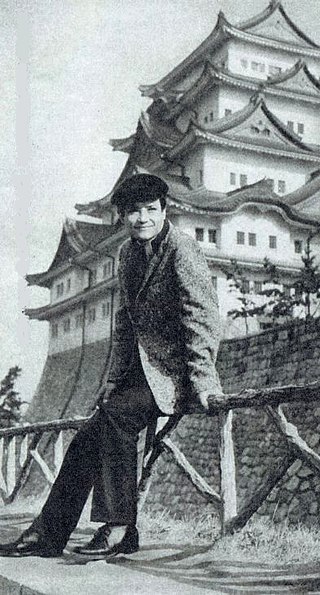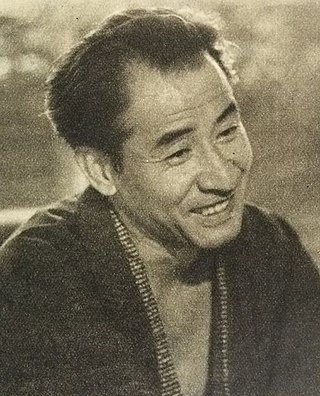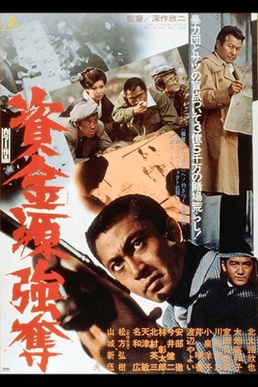Related Research Articles

Akinobu Ogata, better known by his stage name Ken Ogata, was a Japanese actor. He appeared in more than 50 movies and 25 television series. For his merits and contribution to arts in 2000 received Japan's Medal of Honor with Purple Ribbon.

Bakuryū Sentai Abaranger is a Japanese Tokusatsu television show and Toei's twenty-seventh production of the Super Sentai metaseries, and the first series to use TV Asahi's current logo. It aired from 16 February 2003, to 8 February 2004, replacing Ninpu Sentai Hurricanger, and was replaced by Tokusou Sentai Dekaranger. The program was part of TV Asahi's 2003 Super Hero Time block with Kamen Rider 555. The series is based on dinosaurs and explosions. Its action footage was used in Power Rangers Dino Thunder. In addition, episode 10 in nearly its entirety was used for episode 19 of Power Rangers Dino Thunder as an English-dubbed show that the initial three Dino Thunder Power Rangers discover on television.

Atashin'chi is a Japanese comedy manga series by Eiko Kera, and an anime adaptation that was produced from 2002 to 2009. It is an episode-based animated sitcom of the daily experiences of a family of four. An anime sequel called Shin Atashin'chi aired from October 6, 2015 to April 5, 2016 in Japan, and was simulcast on Crunchyroll in certain countries. Select episodes of Atashin'chi and Shin Atashin'chi are available on the official YouTube channel with English subtitles. As of 2024, a new Atashin'chi anime is in production.
Junko Miyashita is a Japanese actress who had a long and varied career working both in pink film and mainstream cinema.

House on Fire is a 1986 Japanese film directed by Kinji Fukasaku. It was chosen as Best Film at the Japan Academy Prize ceremony. The film grossed ¥1.010 billion in Japan.

Sure Death 4: Revenge is a 1987 jidaigeki film directed by Kinji Fukasaku as part of the Hissatsu series of films.

Tadahiko Hayashi was a Japanese photographer noted for a wide range of work including documentary and portraiture.

Kamen Rider Den-O is the seventeenth installment in the popular Kamen Rider Series of tokusatsu programs. It is a joint collaboration between Ishimori Productions and Toei. It premiered January 28, 2007 on TV Asahi, and concluded airing on January 20, 2008. Its lead actor Takeru Satoh is the first Kamen Rider Series lead born in the Heisei period of Japanese history. It aired on the Super Hero Time slot alongside Juken Sentai Gekiranger.
The Japanese Film Festival (JFF) is a film festival held in Singapore and dedicated to Japanese cinema. It was first held in 1983 and then held annually from 1999 to 2016, and curated with Singapore audiences in mind, led by local programmers with a wide-ranging programme of film classics, Japanese independents and commercial releases. There was no festival in 2017. Under new direction from 2018 from the Japan Foundation in Tokyo, it has shifted its focus to screening mainly commercial releases from Japan.

Sō Yamamura, sometimes credited as Satoshi Yamamura, was a Japanese actor and film director.

Haru is a Japanese actress and model from Adachi, Tokyo. She is known for the film Koizora (2007), Maria-sama ga Miteru (2010), the TV drama Asa ga Kita (2015-2016), and for co-hosting of the TBS talk show A-Studio.
Masataka Kubota is a Japanese actor.
Hissatsu Shiokinin (必殺仕置人) is a Japanese television jidaigeki or period drama that was broadcast in 1973. It is the 2nd in the Hissatsu series. Hissatsu Shiokinin is one of the most popular jidaigeki dramas in Japan.
Hissatsu Shiokiya Kagyō (必殺仕置屋稼業) is a Japanese television jidaigeki or period drama that was broadcast in 1975–1976. It is the 6th in the Hissatsu series. Kenji Misumi was hospitalized while directing episode 13 where he later died.
Tasukenin Hashiru (助け人走る) is a Japanese television jidaigeki or period drama, that was broadcast in 1973–1974. It is the third in the Hissatsu series and is based on Saga Sen's Seibei-ryū Gokui.
Kurayami Shitomenin (暗闇仕留人) is a Japanese television jidaigeki or period drama that was broadcast in 1974. It is the 4th in the Hissatsu series. The drama is a sequel to Hissatsu Shiokinin. This would ultimately become the last entry in the Hissatsu series to air on the TBS-run JNN network due to the Asahi Broadcasting Corporation the franchise's producer, switching to the NET-run ANN network.

Cross the Rubicon!, also known as Plundering the Source of Capital and Gambling Den Heist, is a 1975 Japanese yakuza film directed by Kinji Fukasaku.
The Hissatsu series is a long-running prime-time popular television Jidaigeki series about assassins in Japan, produced by ABC Television and Shochiku. Hissatsu Shikakenin is based on Shōtarō Ikenami's novel Shiokinin Fujieda Baian, but its sequels are only inspired by it. The series still continues as an annual two-hour special drama.

Yoichi Hayashi is a Japanese actor. Hayashi is a former Kabuki actor, and appeared in many jidaigeki television dramas.
Taisaku Akino is a Japanese actor.
References
- ↑ "必殺仕掛人". kotobank. Retrieved January 15, 2021.
- ↑ "必殺仕掛人". Jidaigeki.Com. Retrieved 10 August 2017.
- ↑ "必殺シリーズ". TV Asahi. Retrieved March 2, 2019.
- ↑ "必殺シリーズ". 時代劇専門チャンネル. Retrieved March 2, 2019.
- ↑ "知性と狂気を併せ持つ眼 夏八木勲の悪役は恐い!――春日太一の木曜邦画劇場". 週刊文春オンライン. Retrieved August 14, 2021.
- ↑ "必殺仕掛人". tvk. Retrieved January 15, 2021.
- ↑ "必殺仕掛人". TV DRAMA. Retrieved March 2, 2019.
- ↑ "映画監督 三隅研次". National Film Archive of Japan. Retrieved November 22, 2020.
- ↑ "Hissatsu shikakenin". 日本映画製作者連盟. Retrieved 27 November 2020.
- ↑ "Hissatsu shikakenin Baian arijigoku". 日本映画製作者連盟. Retrieved 27 November 2020.
- ↑ "Hissatsu shikakenin Baian shikakebari". 日本映画製作者連盟. Retrieved 27 November 2020.